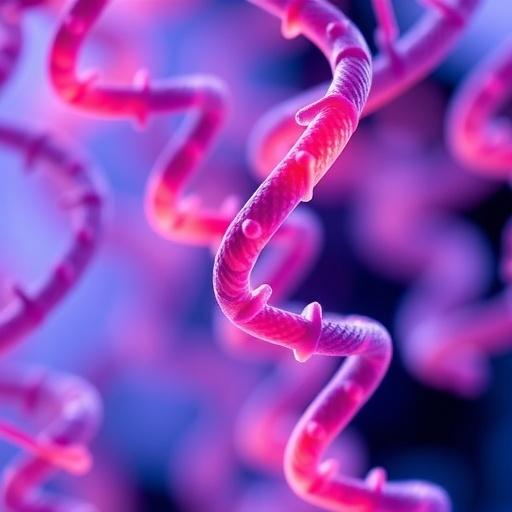
A transformative approach in the realm of cancer treatment has emerged from the Perelman School of Medicine at the University of Pennsylvania, where researchers have harnessed the power of engineered small extracellular vesicles (sEVs) to combat various cancer types effectively. This groundbreaking study presents a significant advancement in immunotherapy, specifically targeting a receptor known as DR5, which is prevalent on the surface of many tumor cells. The findings have the potential to revolutionize treatment strategies, bridging a gap in existing therapies that have struggled to utilize the DR5 target effectively over the past two decades.
The innovative strategy revolves around the manipulation of sEVs, nano-sized particles derived from human cells, to deliver targeted treatment by activating DR5. The ability of these vesicles to induce apoptosis, or programmed cell death, in cancer cells demonstrates their potential as a more rigorous and effective option compared to existing DR5-targeting antibodies, which have previously been the frontrunners in this therapeutic niche.
In a series of laboratory experiments, the engineered sEVs exhibited remarkable specificity in binding to DR5. They efficiently targeted and eliminated cancer cell lines with high DR5 expression, including those from melanoma, liver, and ovarian cancers. The scientists noted that these engineered vesicles not only excelled in cell-killing potency compared to conventional therapeutic antibodies, but they also significantly suppressed tumor proliferation in mouse models, leading to drastically extended survival rates.
Dr. Xiaowei “George” Xu, the senior author and a prominent figure at the Tara Miller Melanoma Center, underscored the clinical implications of this research. He pointed out that, despite significant strides in cancer immunotherapy, a considerable percentage of patients, particularly those with solid tumors like melanoma, remain underserved by current treatments. The potential for sEVs as an “off-the-shelf” therapy that can be administered universally without the need for individual patient cell retrieval makes this development particularly promising.
The strategic targeting of the DR5 receptor reflects a comprehensive understanding of tumor biology and immunology. The receptors have evolved with the biological purpose of mediating the elimination of malignant cells. However, previous attempts to harness this mechanism in cancer treatments have met with limited success. By employing sEVs, Xu and his team have opened new avenues for tumor targeting and immune system engagement.
The research effectively demonstrates that these engineered sEVs can disrupt not only tumor cells but also the supportive components of tumors. The study showcases their ability to attack cancer-associated fibroblasts and myeloid-derived suppressor cells, both crucial players in the immunosuppressive tumor microenvironment. The implications of this transformative approach suggest that it could be crucial in revitalizing immune responses against solid tumors, an area that has posed significant challenges for current immunotherapeutic strategies.
The process of manufacturing these extracellular vesicles is notably simplified, making them more accessible for therapeutic use. The ease of storage and scalability presents additional advantages, paving the way for broader clinical applications. Researchers now face the task of refining the production process to ensure that clinical-grade sEVs can be generated adequately for upcoming human trials, which could potentially expand the therapeutic landscape in oncology.
As the research team moves towards clinical applications, the importance of understanding the safety and efficacy of these engineered sEVs cannot be overstated. Initial steps will involve thorough safety studies, preparing for eventual studies with human subjects. If successful, this novel therapy could provide a much-needed alternative for patients who struggle with conventional cancer treatments.
In conclusion, the innovative approach utilizing engineered small extracellular vesicles to target DR5 presents a new frontier in cancer immunotherapy. It not only demonstrates a potential solution to an ongoing challenge in effective cancer treatment but also serves as a reminder of the dynamic and ever-evolving nature of scientific research. The study, which highlights the importance of interdisciplinary collaboration in medical advancements, is set to have lasting implications for future cancer therapies.
The momentum behind this research continues to build excitement within the scientific community, accentuating the crucial role of innovative methodologies in overcoming the obstacles presented by various malignancies. As these findings progress towards clinical trials, the potential for a breakthrough in cancer treatment is a beacon of hope for many patients and advocates in the oncology field.
Successfully targeting the intricacies of cancer through advanced science is no small feat, and the ongoing efforts to develop effective therapies demonstrate the resilience and ingenuity characteristic of cancer research. The opportunity for a more effective, accessible therapeutic option for cancer patients is now within reach, thanks to these pioneering investigations into engineered sEVs.
The revelations from the study not only enhance the understanding of cancer biology but also emphasize the critical importance of continuously exploring new mechanisms in the face of persistent malignancies that challenge our current medical capabilities. This growing body of evidence crops up at a vital time, with many patients eagerly seeking alternatives to augment their treatment strategies and enhance their quality of life.
As the research unfolds, it is clear that a well-rounded, patient-centered approach to cancer therapy will benefit from such innovative academic endeavors. The initiatives at the University of Pennsylvania are paving the way for a future where engineered extracellular vesicles could redefine the standards of care for individuals battling cancer.
Ultimately, this development in targeting DR5 through engineered sEVs marks a significant step forward in the quest for more effective cancer therapies, underscoring the profound impact that research can have on our collective fight against cancer and its devastating consequences.
Subject of Research: Engineered small extracellular vesicles targeting DR5 for cancer immunotherapy
Article Title: Engineered extracellular vesicles with DR5 agonistic scFvs simultaneously target tumor and immunosuppressive stromal cells
News Publication Date: 15-Jan-2025
Web References: Science Advances Article
References: Funding from National Institutes of Health (CA258113, CA261608, CA114046, CA284182)
Image Credits: Penn Medicine
Keywords: Cancer treatment, immunotherapy, extracellular vesicles, small extracellular vesicles, DR5 targeting, apoptosis, tumor microenvironment, cancer-associated fibroblasts, clinical trials, oncology research.





